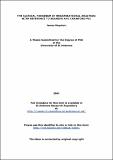The clinical paradigm in organisational analysis : with reference to Beamish and Crawford Plc
Abstract
There has been much discussion in the literature in the past decade as boards of directors
worldwide have faced increasing stakeholder demands for accountability. The
conventional wisdom that stakeholders were passive players, who ceded responsibility
for the company to the board, has gone and been replaced by a growing sensitivity to the
risk of corporate liability. It is still not widely understood that business enterprise is as
much a moral act as an economic one. In the 1980's, boardroom behaviour was perceived
as unresponsive, mercenary, formal, guarded, ritualistic and legalistic. However, we
know little about the culture of these 'managerial elites' (Pettigrew and McNulty, 1995)
but one approach is to adopt a psychoanalytic perspective.
Psychoanalytic theory is, inter alia, a method of understanding group processes.
Bion (1959) and Bridger (1986) postulated that rationality in groups could be
compromised by the activity of 'basic assumptions' or unconscious mechanisms that, in
turn, can impact upon the formation of the group as a social institution (Fenichel, 1945).
The search for deep, underlying structures has been continuously advocated by Geertz
(1973), an anthropologist, and the need to distinguish between 'thin' and 'thick'
description; the former relating to what is merely observable and the latter to an
interpretive, iterative process that seeks out the basic significance of events. The
psychoanalytic model, with its premise of not taking for granted what is directly
observable, presents an opportunity to examine the power of unconscious group
processes in the construction of boardroom decisions.
This research aims to demonstrate that the application of clinical concepts to the analysis
of boardroom relationships can produce an enriching effect on more traditional theories
of organisational functioning.
Type
Thesis, PhD Doctor of Philosophy
Collections
Items in the St Andrews Research Repository are protected by copyright, with all rights reserved, unless otherwise indicated.

